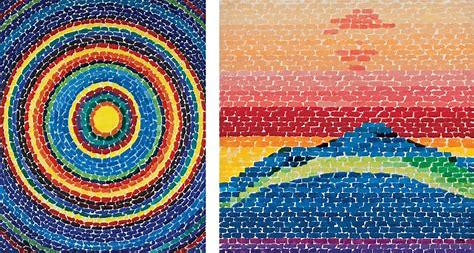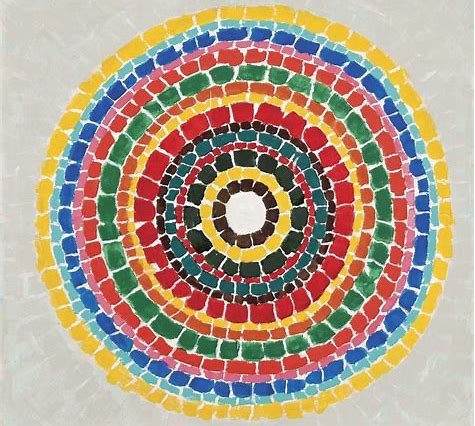Students will learn about radial symmetry and painting based on the techniques of Alma Thomas. Recommended for 2nd Graders.
Color: the visible range of reflected light.
-Primary colors: the basic colors from which all other colors are mixed: red, yellow, and blue; no other colors can be mixed to make primary colors.
-Secondary Colors: created by mixing two primary colors: blue & yellow=green, blue & red= violet, and red & yellow= orange.
Shape: a two-dimensional (flat) area enclosed by a line. Shapes can be geometric (straight edges, often symmetrical) or organic (curved edges, asymmetrical).
Balance: the way the elements are arranged so that individual parts appear equally distributed visually throughout the composition. i.e. spread out in a visually interesting way.
-Radial Symmetry: a type of balance that is equally symmetrical from the center point throughout. All elements radiate from the center point.
-Symmetrical/Formal Balance: exact appearance on opposite sides of a dividing line or plane.
Pattern: elements that repeat. In this lesson it is color and the shape of the brushstrokes.
Brushstroke: the shape the brush makes when it touches the surface.
Craftsmanship: neatness, control of tools. In this lesson it’s making careful, repeated brushstrokes.
Non-representational Art: a design not intended to be a picture of anything.
Representational Art: a picture of something, however simplified.
• Images of Thomas’ paintings

"Man's highest aspirations come from nature. A world without color would seem dead. Color is life. Light is the mother of color. Light reveals to us the spirit and living soul of the world through colors."—Press Release, Columbus Museum of Arts and Sciences, 1982, for an exhibition entitled A Life in Art: Alma Thomas 1891–1978.
Alma Thomas retired from teaching art in 1960, after thirty-eight years in Washington, D.C. and she began to paint seriously. In the years that followed, she would come to be regarded as a major painter of the Washington Color Field School. This painting style involved using large fields of solid color. Alma Thomas used large repeated dabs of color, separated by white space in both representational and non-representational ways.


What does Alma Thomas’s work remind you of? (Small colored pebbles, small tiles/mosaics, colored glass, rainbows, etc.; there are no wrong answers.)
What colors do you see in her work? (Primary & secondary.)
Which paintings show symmetry? Which show radial symmetry?
Which paintings are representational? Which are non-representational?
Students will: create a radially symmetrical balanced painting; view work and use painting techniques of Alma Thomas; use art vocabulary; use good craftsmanship when repeating brushstrokes.
Before students arrive:
Lesson written by Juliette Ripley-Dunkelberger. Artist Bio from Artsy website and Smithsonian American Art Museum. Drawing for Mindfulness art lesson video featuring similar project; additional Alma Thomas art lesson video.
21st Century Thinking Skills
Goal setting, creating, innovating, taking responsible risks, reflecting, observing, making connections, sequencing, predicting, comparing/contrasting, determining main idea, problem solving, cause and effect, evaluating.
WA State Learning Standards
VA:Cr2.1.2 a. Experiment with various materials and tools to explore personal interests in a work of art or design.
VA:Cr2.2.2 a. Demonstrate safe procedures for using and cleaning art tools, equipment, and studio spaces.
VA:Cr3.1.2 a. Discuss and reflect with peers about choices made in creating artwork.
VA:Re7.1.2 a. Perceive and describe aesthetic characteristics of one’s natural world and constructed environments. This happens when identifying the artist’s choice of representing images.
VA:Re8.1.2 a. Interpret art by identifying the mood suggested by a work of art and describing relevant subject matter and characteristics of form.
Arts Integration Opportunities
Math: use sequenced patterns of numbers to make a ‘number circle’. In markers or pencils.
Spelling: use spelling words repeated as circles radiating from central point.
Use stamps instead of dots.
Use colored rectangular or square paper ‘chips’ and glue in circles.
Radiate straight lines from a central point using a ruler.
Science: look for evidence of symmetry in nature.
Please note: These lesson plans are intended for non-profit use only. Use of these plans for commercial purposes should give attribution to the Issaquah Schools Foundation and be accompanied by a nominal donation at www.isfdn.org/donate. Thank you.
Fueling Success for Every Student, Every School